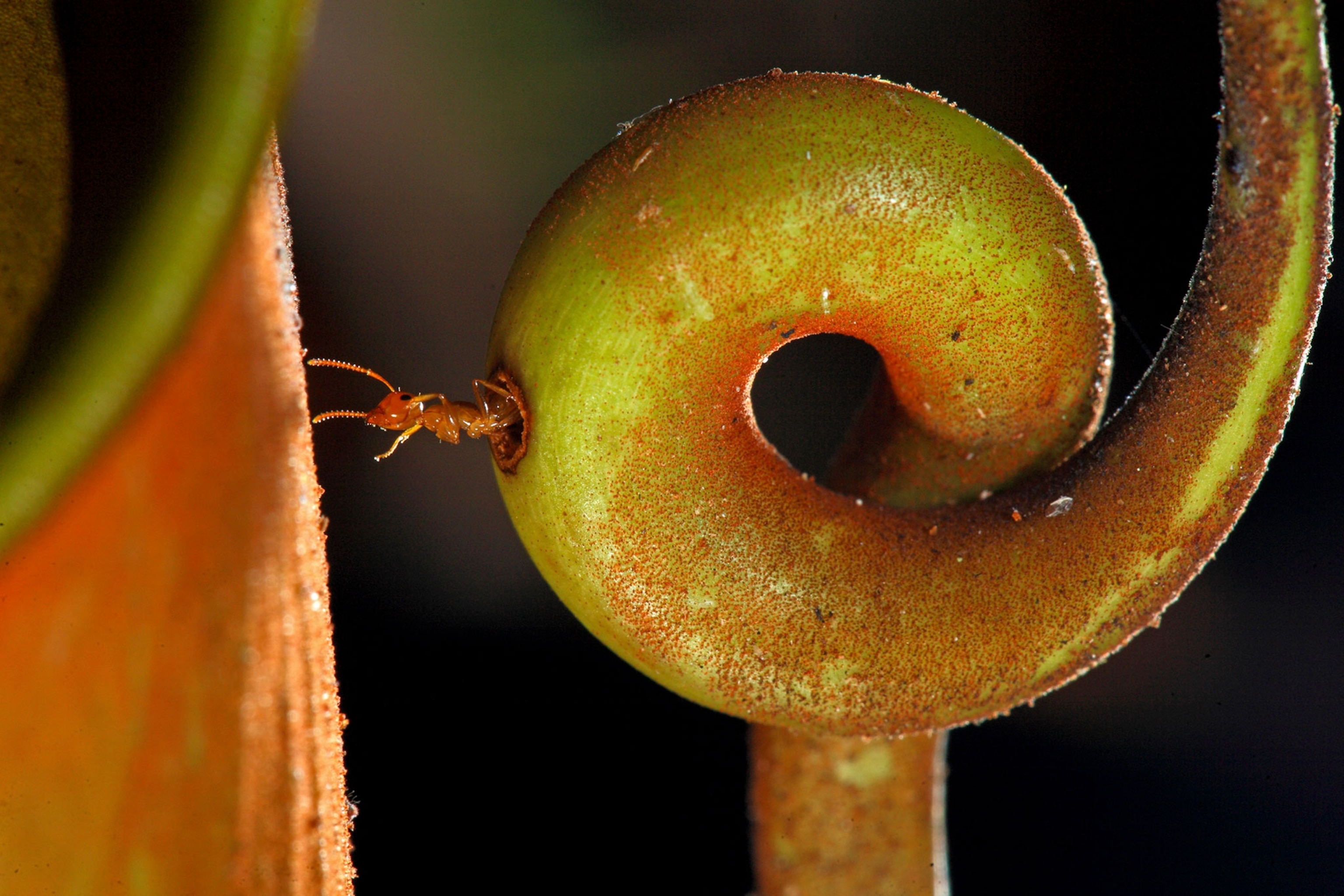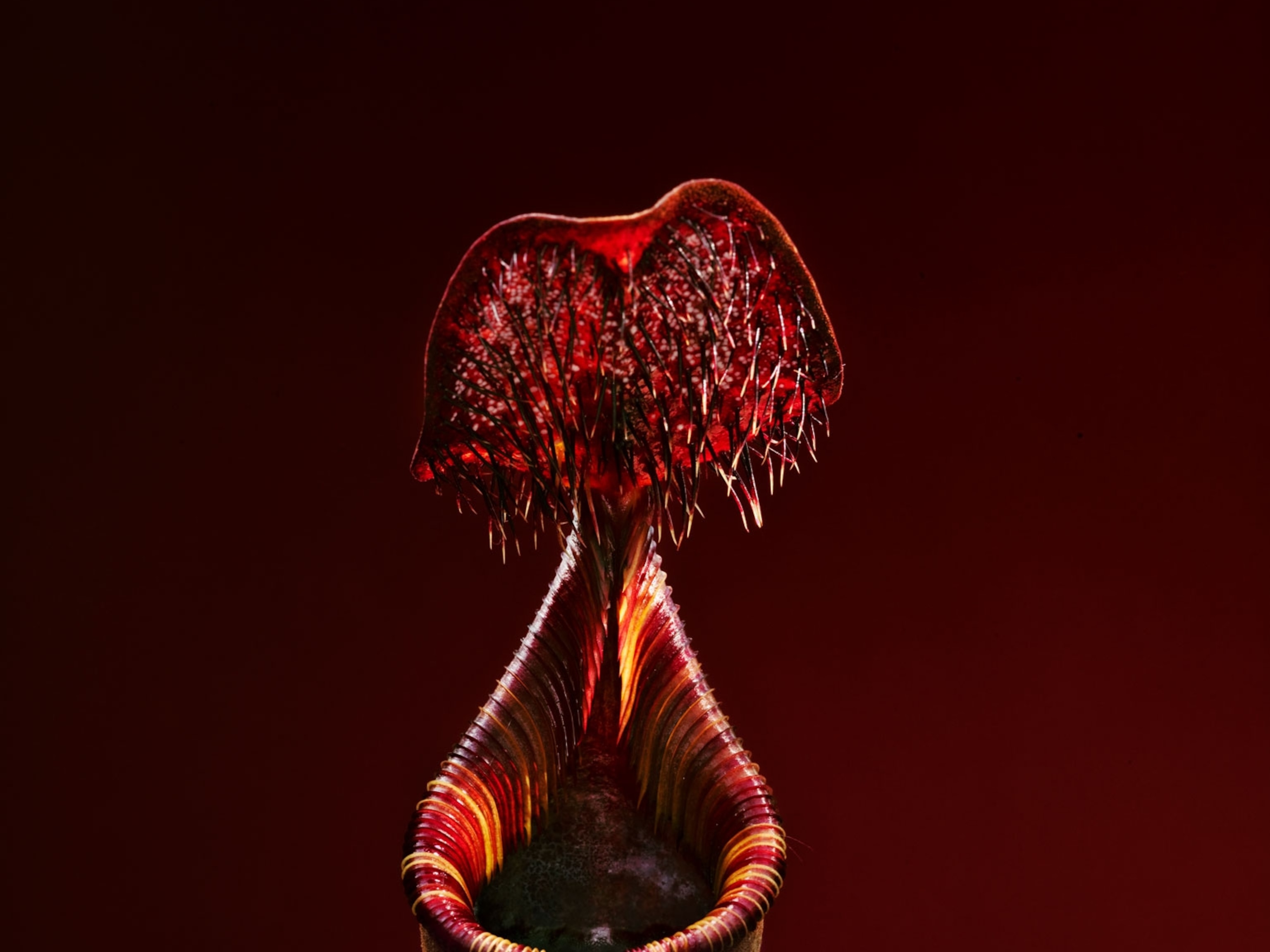
The Living, Breathing World of Borneo’s Carnivorous Pitcher Plants
Tropical biologist turned photojournalist Christian Ziegler spends a lot of his time documenting the world’s rain forests and has a particular place in his heart for the leafy inhabitants of these beautiful and complex environments. Here, he shares photographs from a trip to Borneo, where he witnessed surprisingly enterprising relationships between pitcher plants and the creatures living around them.
We often don’t give plants enough credit. When observing nature, a lot of our attention is devoted to animals. Yet there is a lot to discover in the plant kingdom; in fact, they exhibit much more “behavior” then one might expect.

I am fascinated by the carnivorous Asian pitcher plant, and in 2013 I spent six weeks in Borneo exploring them more. The Asian pitchers—of which there are 240 species in the genus called Nepenthes—are distant cousins to the pitchers, sun dews, and Venus fly traps found in North America. All of them grow beautifully shaped pitchers, partially filled with a digestive liquid, on the tips of their leaves. Some are tiny, the size of a thimble, while the biggest one can hold more than half a gallon.

Borneo is the center of diversity in pitcher plants, and I headed for the lowland swamp forests of Brunei, some of the last lowland forests that have not been converted to palm oil plantations. I also traveled to the mighty Mount Kinabalu, southeast Asia’s highest mountain at 13,435 feet and home to some 25 species of pitcher plants, some of them endemic to the mountain.
My trip was inspired by recent research suggesting that many pitcher plants have very specific “diets.” Carnivory in plants has evolved several times in independent places—always in very nutrient poor habitats—as a way for the plant to gain additional nutrients. Until recently, all pitchers were thought to capture insects, but as is often the case, the reality is more complicated. In fact, scientists have discovered a number of unexpected ways that pitcher plants survive, often involving mutualism with animals.

My first surprise in the swampy, steamy forest of Brunei was a vegetarian carnivorous plant. It turned out that the digestive enzymes in that pitcher are best suited to break down plant matter, not animal. One recently discovered species “collaborates” with a tiny bat, which uses the elegant, long pitchers as a place to sleep in the daytime. The bats feces and urine provide the plant with sought after nutrients.


In that same forest one can find a species of pitcher plant that houses its own cleaning crew: A small colony of ants resistant to its digestive juices lives in its hollow stem. In fact, the ants can swim and dive in the liquid without drowning, and make a chore of dragging large dead insects out of the pitcher, which would otherwise spoil the digestive process.

Climbing Mount Kinabalu, hiking through different forest zones, I get to see a great variety of pitcher shapes and sizes and pitchers being used as a safe place for the eggs of snails and certain frogs. I spend the last week of my trip photographing the largest known pitcher plant—Rajah’s pitcher (N. rajah) and its close relationship with a mountain tree shrew. Rajah’s pitcher lays on its side, its large lid with nectar glands sticking up. When the shrews visit to lick the nectar, its feces end up in the pitcher, providing nourishment for the plant.
I leave Borneo impressed and awed by just how much behavior these pitcher plants display and amazed at how much more there is to explore and discover in the vegetable kingdom.
For more animal-plant interactions, check out Ziegler’s piece on the Ochroma tree of PanamaOchroma tree of Panama. You can also follow Ziegler on his website.
Related Topics
You May Also Like
Go Further
Animals
- How can we protect grizzlies from their biggest threat—trains?How can we protect grizzlies from their biggest threat—trains?
- This ‘saber-toothed’ salmon wasn’t quite what we thoughtThis ‘saber-toothed’ salmon wasn’t quite what we thought
- Why this rhino-zebra friendship makes perfect senseWhy this rhino-zebra friendship makes perfect sense
- When did bioluminescence evolve? It’s older than we thought.When did bioluminescence evolve? It’s older than we thought.
- Soy, skim … spider. Are any of these technically milk?Soy, skim … spider. Are any of these technically milk?
Environment
- Are the Great Lakes the key to solving America’s emissions conundrum?Are the Great Lakes the key to solving America’s emissions conundrum?
- The world’s historic sites face climate change. Can Petra lead the way?The world’s historic sites face climate change. Can Petra lead the way?
- This pristine piece of the Amazon shows nature’s resilienceThis pristine piece of the Amazon shows nature’s resilience
- Listen to 30 years of climate change transformed into haunting musicListen to 30 years of climate change transformed into haunting music
History & Culture
- Meet the original members of the tortured poets departmentMeet the original members of the tortured poets department
- Séances at the White House? Why these first ladies turned to the occultSéances at the White House? Why these first ladies turned to the occult
- Gambling is everywhere now. When is that a problem?Gambling is everywhere now. When is that a problem?
- Beauty is pain—at least it was in 17th-century SpainBeauty is pain—at least it was in 17th-century Spain
Science
- Here's how astronomers found one of the rarest phenomenons in spaceHere's how astronomers found one of the rarest phenomenons in space
- Not an extrovert or introvert? There’s a word for that.Not an extrovert or introvert? There’s a word for that.
- NASA has a plan to clean up space junk—but is going green enough?NASA has a plan to clean up space junk—but is going green enough?
- Soy, skim … spider. Are any of these technically milk?Soy, skim … spider. Are any of these technically milk?
Travel
- Dina Macki on Omani cuisine and Zanzibari flavoursDina Macki on Omani cuisine and Zanzibari flavours
- How to see Mexico's Baja California beyond the beachesHow to see Mexico's Baja California beyond the beaches
- Could Mexico's Chepe Express be the ultimate slow rail adventure?Could Mexico's Chepe Express be the ultimate slow rail adventure?




